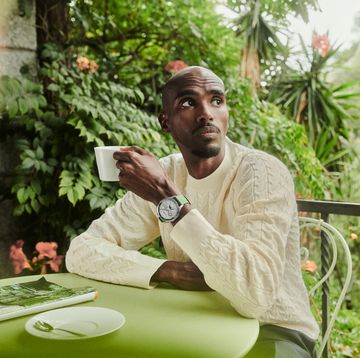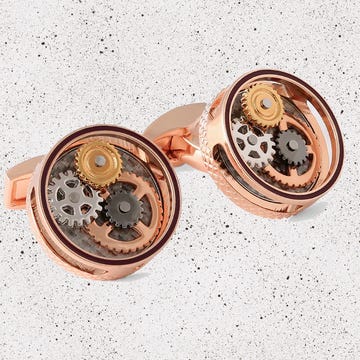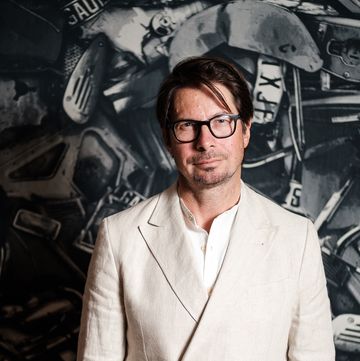For many, the most heart-stopping moment in the latest James Bond film was not Bond’s duel with an assassin atop a Shanghai skyscraper. Nor was it the hair-raising pursuit through the tunnels of the London Underground. It was not even the climactic showdown on the wind-swept Scottish moors. Rather, it occurs around two-thirds of the way into the film, when Bond arrives at a lock-up on a drab London side street and yanks up the roller-shutter door.
At that moment, cinemas across Britain were filled with a sound pitched somewhere between an exultant cry of recognition and a deep, almost orgasmic sigh. For there stands a gleaming 1964 Aston Martin DB5. Sean Connery first drove one in Goldfinger, and in many people’s minds it’s the only Bond car. And not just Bond’s car, but the car of your and everybody else’s dreams – a Proustian flash of glamour, style, class, sex. Probably the most beautiful car ever made in Britain.
Even within the heady echelons of luxurious and eye-wateringly expensive sports cars, the Aston Martin has always been a rarified and exceptional beast. In the hundred years of its existence, the company has manufactured just 65,000 cars – 50,000 of them in the last 13 years. It is the automotive equivalent of the Savile Row suit, with the resonance of timeless quality, craftsmanship, a style that transcends fashion and an essential Englishness.
It is traditionally said of Aston Martin that it’s the gentleman’s sports car. (Indeed, you might describe Bond as a sort of fantasy version of the English gent – shooting the cuffs of that Savile Row suit, before he shoots anything else.) Its natural habitat is a gravel drive outside a particularly fine Tudorbethan manor house in a leafy corner of England; a fast, twisting stretch of road through the Cotswolds; en route to the Scottish Highlands; or the Corniche between Nice and Menton.
An Aston Martin might roar, but it doesn’t shout – it doesn’t have to. It bespeaks taste and discretion and driving one carries with it a certain set of obligations. It stands apart from the nouveau riche vulgarity of the lime-green Lamborghini or the canary-yellow Ferrari. The most popular colour in the Aston Martin palette is silver. You would not expect to find one clamped outside Harrods. It would be... unseemly. Actually, downright vulgar.
The Aston Martin headquarters at Gaydon, in Warwickshire, is a tan-brick modernist building set in landscaped grounds, with Astons of sundry vintage carefully ranged around like sculptures. Passing through the sliding doors, you step into a space resembling an art gallery (it is modelled on Mies Van Der Rohe’s Barcelona Pavilion) with natural light pouring in through the floor-to-ceiling glass and the current range of Astons displayed like high-performance exhibits. In the VIP waiting area, a black DB6 from the Sixties that used to belong to Paul McCartney stands alongside a gleaming red prototype model of the company’s new flagship, the V12 Vanquish – its leaner, more powerful, more streamlined, and more costly offspring.
A combination of speed and exclusivity has been the hallmark of Aston Martin since automotive engineers Lionel Martin and Robert Bamford founded the company in 1913. The first model, nicknamed the Coal Scuttle because of its distinctive bonnet shape, was advertised as “a car for the discerning owner driver with fast touring in mind. Designed, developed and built as an individual.”
Through the Twenties and Thirties, the Aston Martin was the quintessential high-performance luxury road car, and a staple of the motorsport circuit; the car that a gentleman would spin around Brooklands circuit in or drive down through France to race at Le Mans. But it was always a precarious financial concern.
In its first 25 years of existence, the company changed hands three times. If the Aston has been a rich man’s plaything, the company itself could sometimes have been described in the same way. The man who truly put Aston Martin on the map was David Brown, who in 1947 answered a classified advertisement in The Times seeking an owner for “a high-class motor business”. Brown acquired Aston Martin for £20,500. A qualified pilot who owned race horses and raced cars and motorbikes, Brown, had made his fortune manufacturing tractors. Under his ownership the company produced a series of cars bearing the famous “DB” appellation which established Aston Martin as the acme of beautiful design and technical excellence. Of these, the DB5 remains the most iconic. Just 1,059 were manufactured between 1963 and 1965. Priced then at just over £4,000, to buy a good one now would cost you more than £400,000.
In 1972, Brown divested himself of the company, leading to a long and troubled period involving several changes of ownership and near collapse. The marque became tarnished with an unwelcome reputation for being unreliable, poorly made and badly designed; the Aston Martin Lagonda luxury sedan, launched in 1976, was named by Time magazine as one of the 50 worst cars of all time.
In 1992, Aston Martin manufactured just 42 cars.
It was a takeover by Ford, who bought Aston Martin in 1991, that effectively saved the marque. Ford poured millions of pounds into the company, establishing it in its present headquarters at Gaydon and developing new models that restored the brand’s tarnished reputation.
In 2007, Ford divested itself of all the subsidiaries in its Premier Automotive Group: Jaguar, Land Rover, Volvo and Aston Martin. Aston Martin was bought by two Kuwaiti companies, Investment Dar and Adeem Investment, who were joined last year by an Italian private equity company, Investindustrial.
Every part of the Aston Martin is designed and built at Gaydon, with the exception of the engine, which is made in Cologne. The backbone of Aston design is what it calls “VH architecture”. This is the basic platform on which the car is built, and which can be extended vertically or horizontally to accommodate a variety of bodies, from the smallest car (the V8 Vantage) to the largest (the four-door Rapide).
Introduced in 2000, VH architecture has enabled the company to develop different models without the need for a total (and costly) reinvestment in each one. In the Nineties, Aston was producing just two models. It now produces five, with eight different derivatives, running from the (relatively) affordable V8 Vantage, which starts at a mere £84,995, to the V12 Vanquish at £189,995. (The special Centenary Vanquish has a slight premium, pushing it over £200,000, although at those Himalayan price altitudes, the extra £10,000 or so shouldn’t make that much difference.)
Until 2000, 75 per cent of Aston Martins were sold in the UK. Sales are now more evenly divided between the UK, the US, Europe and emerging markets such as China and India.
Every Aston Martin is built to order and – like that Savile Row suit – tailor-made for the customer. Prospective buyers are invited to Gaydon to choose, and be schmoozed, on model, colour, interiors and extras.
There are 30 standard colours in the Aston Martin palette, but if you want your Vanquish to match your favourite polo shirt, they’ll do it. One woman specified that the upholstery stitching should match her favourite lipstick. Customers are also invited to tour the factory to observe the building of their car through its various stages, from the construction of the bonded aluminium platform, to the final fitting of the “spread wings” bonnet and boot badges.
They can even see a small plaque attached to the engine block bearing the name of the engineer who signed off the car at its final inspection. (Another plaque “Hand built for...” can be added at the owner’s discretion.)
“We use three words: power, beauty and soul,” says Marek Reichman, 47, Aston Martin’s director of design. “The beauty bit is important, because no other brand uses that in their core description. But the difference is that an Aston Martin today looks beautiful and an Aston Martin in 50 years will look beautiful. Our core values are great proportion, great surfacing and great design, which are timeless. We are not a fashion brand. Fashion brands follow the marketplace. If you like, we create haute couture that leads every one else.”
Reichman was born in Sheffield. After studying industrial design and gaining a masters in vehicle design at the Royal College of Art, he worked for nine years in the US for BMW, before moving to Ford, where he designed the last-generation Range Rover, and then ran the Rolls-Royce Phantom project. He joined Aston Martin in 2005 and has been responsible for designing every model since.
Pleasingly, the journey towards a £200,000 motor car begins with Reichman sketching with a 30p black Bic biro on A4 layout paper. “It has semi-translucency, so you can look at your sketch back to front, which is helpful for the lines,” he explains. That original sketch is then scanned using a CAD programme, before being modelled in clay, which is then coated in Dynoc film to produce a perfect facsimile model of the future car. This model is then appraised for line, contour and play of light.
“An Aston Martin is a piece of sculpture,” Reichman says. “We are not mass producing. Our cars are more like pieces of art: less product designed and more emotional. Before it becomes a production car, you have to produce an object to say, this is it – this is the future.”
Reichman is someone who pays attention to matters of taste: he boils his water in an Alessi kettle, makes his coffee in a Pavoni coffee machine, has Breuer chairs and Charles Eames loungers. He has his suits made at Henry Poole. And he drives a Vanquish. He talks about “the golden section” – the universal measure of symmetry and proportion which he says dictates his designs: “Millimetres matter, because we see them. If you change anything by a couple of millimetres in any direction, you get a completely different object. But if you get that golden section right, you will get an object that people will want to look at and desire. Beauty is a universal thing that we can all recognise, and everyone has to see that through our product, in its aesthetic quality and the beauty of its performance.”
What is also being strived for is something that can’t be measured by a computer or micrometer: mystique. It is the indefinable quality, as Reichman puts it, that has other drivers giving way at road junctions to let the Aston out first, that sees pedestrians giving you the thumbs-up as you drive past, that attracts glances of “…admiration, not envy”. Reichman says he knows of Aston Martin drivers who have been pulled over by the police for speeding, but after a quick, admiring glance at the bodywork, let go with a friendly warning. “It wouldn’t happen with any other sports car. There’s a respect there,” he says.
Traditionally, Aston Martin has never advertised. It has never needed to. The association with James Bond has been probably the most successful product placement exercise in the history of cinema, with Astons having featured in 11 Bond films.
Although not everybody thinks this is necessarily a good thing. One Aston Martin owner described it to me as a “defilement” of a distinguished marque, and not even particularly effective: “How many people who watch a James Bond film will actually buy an Aston Martin?” You might equally ask, how many people who buy an Aston Martin do so because of the association with Bond? The answer is probably very few.
Reichman talks of Aston Martin owners as being “cultured”, “stylish”, of “appreciating the finer things in life”. He doesn’t need to add that they tend to be extremely wealthy. The Aston Martin inhabits a world where, when it comes to buying an expensive car, the choice is not so much “either, or” as “and, and”. We are talking here of “stables” of cars, of – a favoured word within Aston Martin – “portfolios”.
“Quite often,” Reichman says, “the Aston owner will have a Bentley, they will have a Lamborghini and an Aston. The Lamborghini may be for one Sunday every month for a few hours, and ‘I own it’. But the car I can drive and use every day is the Aston Martin. It has to feel useable, because we want our customers to enjoy the car in exactly that way. Which car should I take today? I’m going to take the Aston Martin because it feels so easy to drive. But if you press all the buttons, you get a very hardcore product that you can go and razz round the track and that will shake your bones.”
Reichman suggested I should take the new Vanquish for a drive. It was crouched in an executive parking space like an animal waiting to be taken off its leash. The first thing to be said for it is that it is a stunningly beautiful incarnation of elegance, luxury and power. The second is that it fitted me like a glove – less like I was getting into the car, than the car was somehow wrapping itself around me.
I tootled up the M40 doing 90mph without even realising it, as other cars scurried to get out of my way. The potential for feeling inordinately pleased with yourself seemed boundless. There is a “Sports” button on the steering column that you can press to make the throttle response sharper, while at the same time modifying the steering weight and making it slightly heavier and easier to control at high speed. There is also something called an “Adaptive Damping” button, which you can set for “normal, sport and track” modes. I didn’t get round to playing with that. Nor did I get round to the state-of-the-art infotainment system, with its hand-crafted capacitive glass buttons offering “haptic feedback” control. It felt less like driving a high-performance sports car than a luxurious boutique hotel room.
But that was fine by me. It was, to put it bluntly, out of this world. In fact, I could find only one thing wrong with it: I had to give it back.
Taken from Esquire's Big Black Book: the style manual for successful men, on newsstands now. Photographs by Benedict Redgrove.
***
MORE CARS:
The New Bugatti Legend
2014's Most Exciting Cars
The Coolest Cars From Frankfurt Motor Show
***









